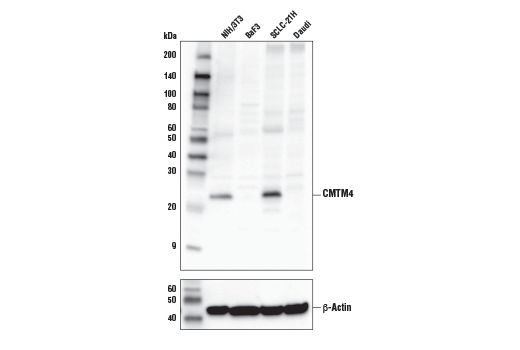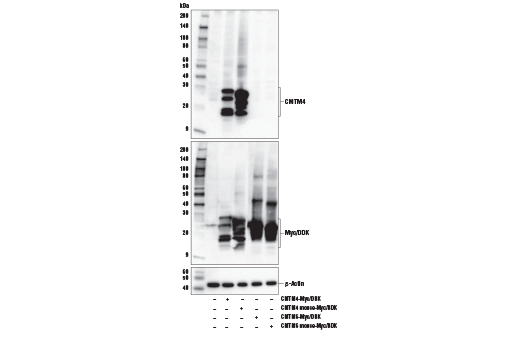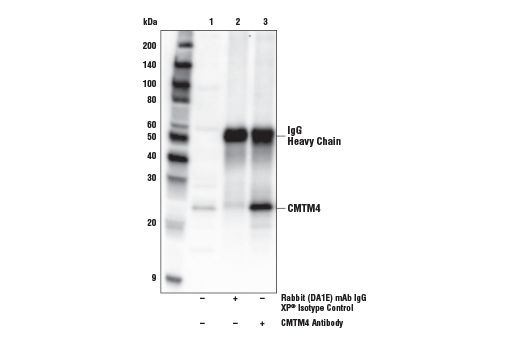WB, IP
H M
Endogenous
22
Rabbit
#Q8IZR5
146223
Product Information
Product Usage Information
| Application | Dilution |
|---|---|
| Western Blotting | 1:1000 |
| Immunoprecipitation | 1:200 |
Storage
Specificity / Sensitivity
Species Reactivity:
Human, Mouse
Species predicted to react based on 100% sequence homology
The antigen sequence used to produce this antibody shares
100% sequence homology with the species listed here, but
reactivity has not been tested or confirmed to work by CST.
Use of this product with these species is not covered under
our
Product Performance Guarantee.
Hamster, Bovine
Source / Purification
Polyclonal antibodies are produced by immunizing animals with a synthetic peptide corresponding to residues surrounding Glu202 of human CMTM4 protein. Antibodies are purified by protein A and peptide affinity chromatography.
Background
CKLF-like MARVEL transmembrane domain-containing protein 4 (CMTM4) is a member of the chemokine-like factor (CKLF)-like MARVEL transmembrane domain-containing family (1). CMTM4 acts as a tumor suppressor in various malignancies, and regulates cell growth and transition through the cell cycle in HeLa cells (1-4). CMTM4 plays an important role in angiogenesis, enabling internalization of membrane-bound vascular endothelial cadherin at adherens junctions, mediating endothelial barrier function, and controlling vascular sprouting (5). In the immune system, CMTM4 acts as a backup for CMTM6 to regulate plasma membrane expression of PD-L1, an immune inhibitory ligand critical for immune tolerance to self and anti-tumor immunity (6-8). CMTM4 may also protect PD-L1 from being polyubiquitinated and targeted for degradation (8). Due to the roles of CMTM4 in the immune system and as a tumor suppressor, it is being investigated as a therapeutic target for the treatment of cancer.
- Plate, M. et al. (2010) Mol Cells 29, 355-61.
- Li, T. et al. (2015) J Exp Clin Cancer Res 34, 122.
- Zhang, H. et al. (2015) Iran J Basic Med Sci 18, 1020-6.
- Bei, C. et al. (2017) Onco Targets Ther 10, 5439-43.
- Chrifi, I. et al. (2018) Angiogenesis , .
- Mezzadra, R. et al. (2017) Nature 549, 106-10.
- Imamovic, D. and Vranic, S. (2017) Ann Transl Med 5, 467.
- Burr, M.L. et al. (2017) Nature 549, 101-5.
Species Reactivity
Species reactivity is determined by testing in at least one approved application (e.g., western blot).
Western Blot Buffer
IMPORTANT: For western blots, incubate membrane with diluted primary antibody in 5% w/v BSA, 1X TBS, 0.1% Tween® 20 at 4°C with gentle shaking, overnight.
Applications Key
WB: Western Blotting IP: Immunoprecipitation
Cross-Reactivity Key
H: human M: mouse R: rat Hm: hamster Mk: monkey Vir: virus Mi: mink C: chicken Dm: D. melanogaster X: Xenopus Z: zebrafish B: bovine Dg: dog Pg: pig Sc: S. cerevisiae Ce: C. elegans Hr: horse GP: Guinea Pig Rab: rabbit All: all species expected
Trademarks and Patents
Limited Uses
Except as otherwise expressly agreed in a writing signed by a legally authorized representative of CST, the following terms apply to Products provided by CST, its affiliates or its distributors. Any Customer's terms and conditions that are in addition to, or different from, those contained herein, unless separately accepted in writing by a legally authorized representative of CST, are rejected and are of no force or effect.
Products are labeled with For Research Use Only or a similar labeling statement and have not been approved, cleared, or licensed by the FDA or other regulatory foreign or domestic entity, for any purpose. Customer shall not use any Product for any diagnostic or therapeutic purpose, or otherwise in any manner that conflicts with its labeling statement. Products sold or licensed by CST are provided for Customer as the end-user and solely for research and development uses. Any use of Product for diagnostic, prophylactic or therapeutic purposes, or any purchase of Product for resale (alone or as a component) or other commercial purpose, requires a separate license from CST. Customer shall (a) not sell, license, loan, donate or otherwise transfer or make available any Product to any third party, whether alone or in combination with other materials, or use the Products to manufacture any commercial products, (b) not copy, modify, reverse engineer, decompile, disassemble or otherwise attempt to discover the underlying structure or technology of the Products, or use the Products for the purpose of developing any products or services that would compete with CST products or services, (c) not alter or remove from the Products any trademarks, trade names, logos, patent or copyright notices or markings, (d) use the Products solely in accordance with CST Product Terms of Sale and any applicable documentation, and (e) comply with any license, terms of service or similar agreement with respect to any third party products or services used by Customer in connection with the Products.


